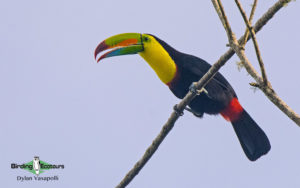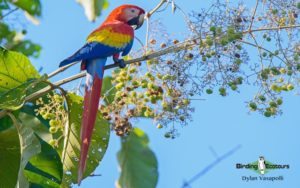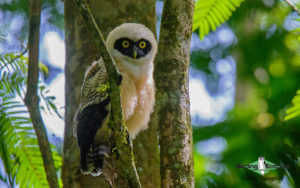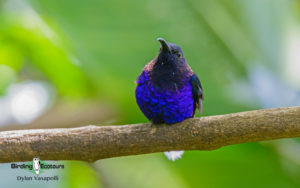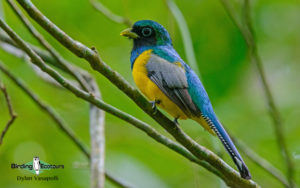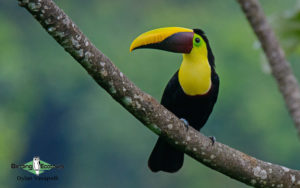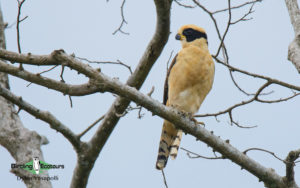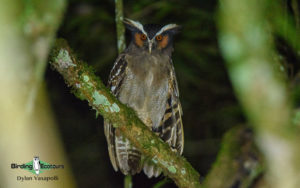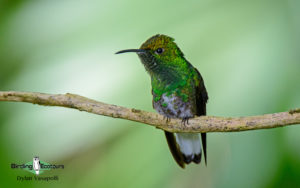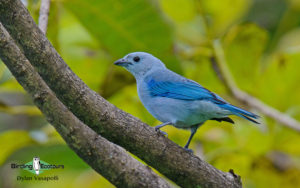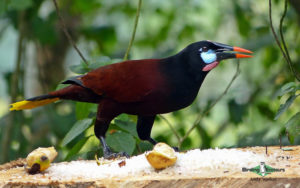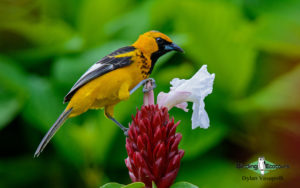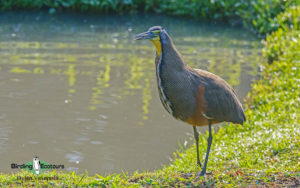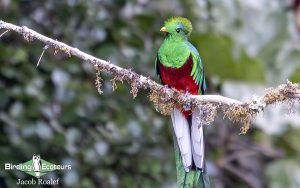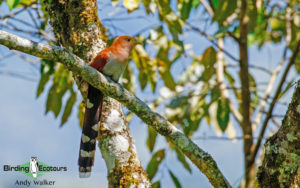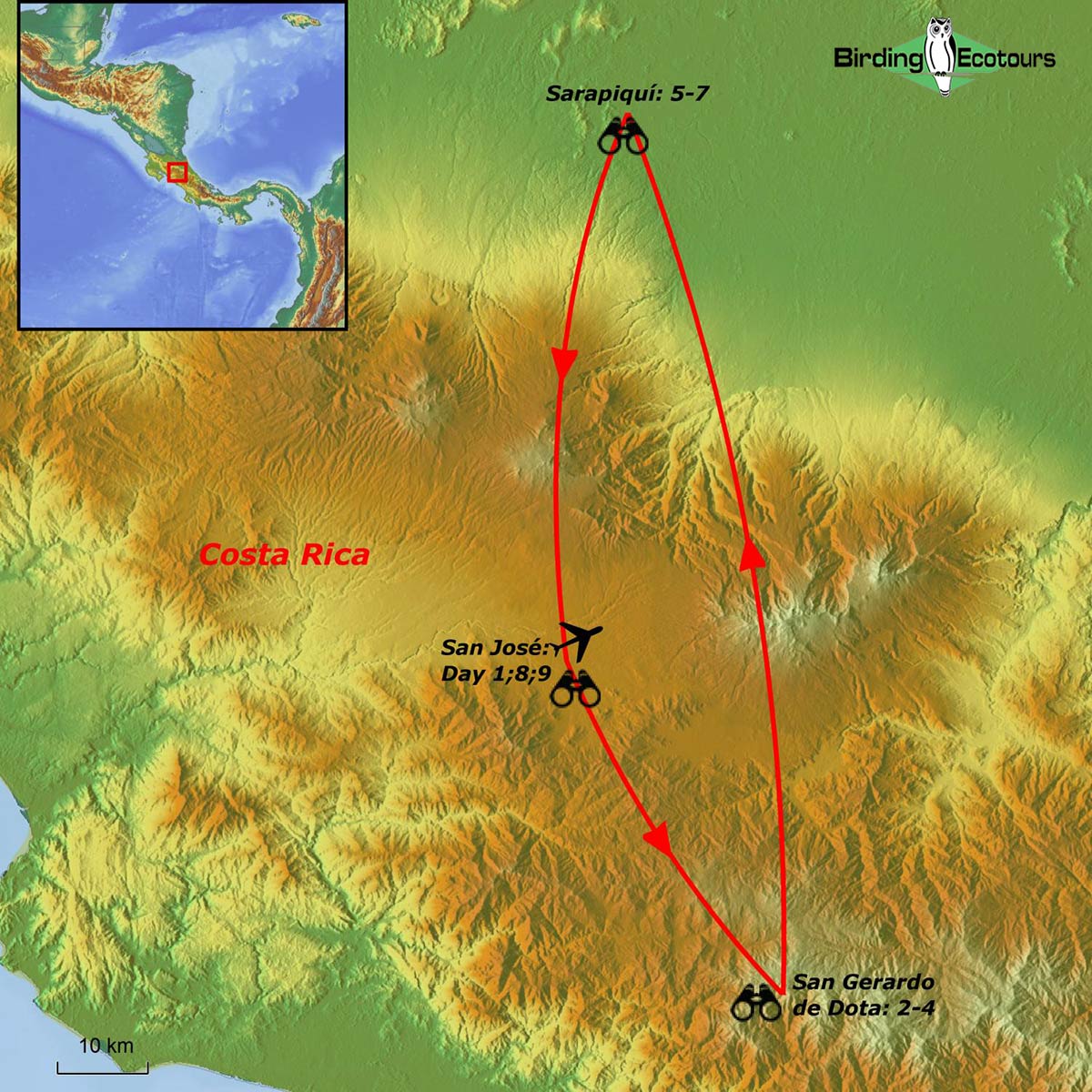Birding Tour Costa Rica Escape
Costa Rica Escape Tour
January 2026/2027
We believe this expertly tailored Costa Rica birding tour is the perfect excuse to leave behind the daily stress of modern-day living to do some great birding in one of the most fantastic birdwatching destinations in all of the neotropics.
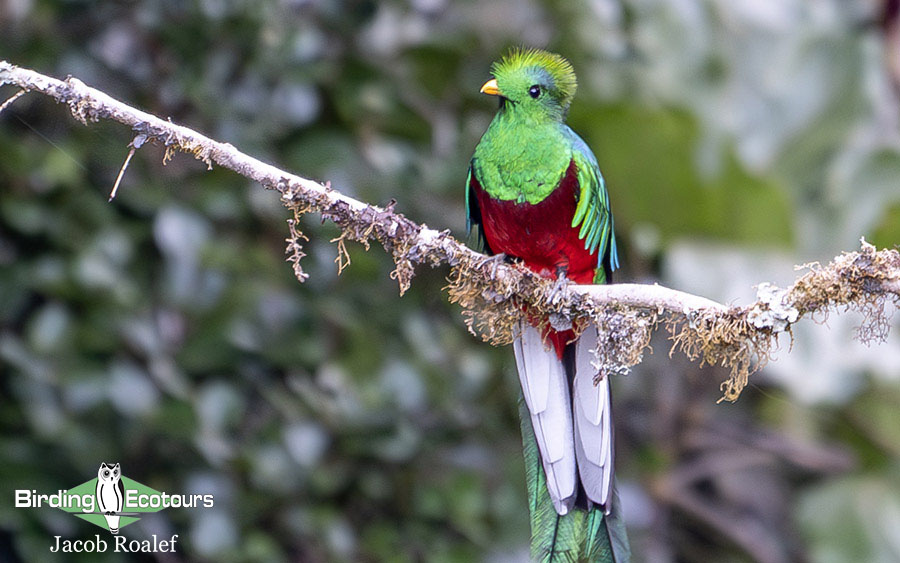
Costa Rica offers perhaps the best birding in Central America, not only in terms of birds (the country holds 933 species) but also in terms of accommodation and tourist infrastructure. During this short tour we are staying at some of the most comfortable hotels available, perfect for birders and nature-lovers alike. The tour is suited for both first-time birders to the neotropics and those more experienced birders trying to get a high number of species in the shortest amount of time. Not only does this tour offer an impressive species list but it also offers you the opportunity to see a number of neotropical dream birds such as Keel-billed Toucan, Resplendent Quetzal and a plethora of gorgeous hummingbird species.
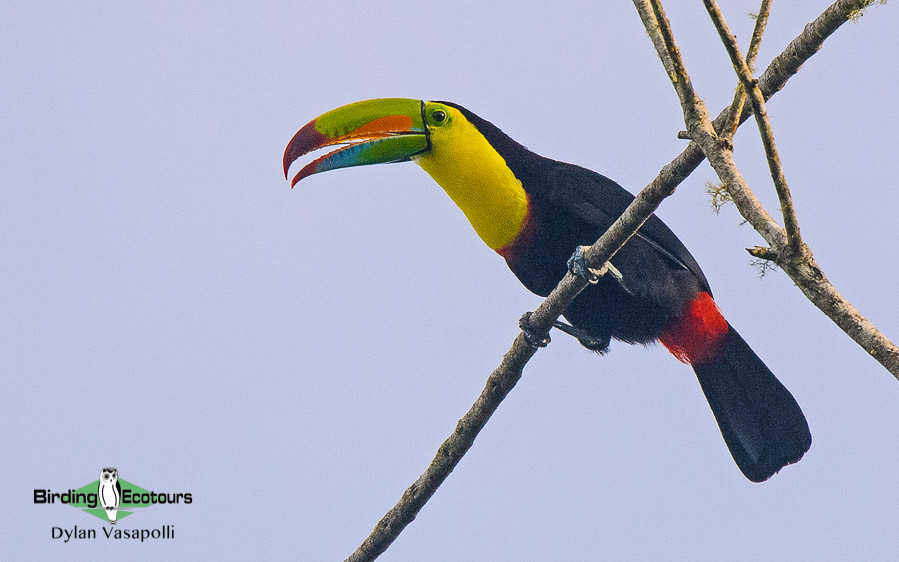
Itinerary (9 days/8 nights)
Day 1. Arrival at San José and transfer to Hotel Bougainvillea
You will arrive at the San José Airport to be met by your tour leader, and be transferred to the hotel. If time permits, we may do some birding around the beautiful grounds of the hotel, looking for Rufous-backed Wren, Hoffmann’s Woodpecker, Finsch’s Parakeet, Squirrel Cuckoo, Baltimore Oriole, Cinnamon-bellied Saltator, American Yellow Warbler, Lesson’s Motmot, White-winged Dove, Rufous-tailed Hummingbird, Clay-colored Thrush, Yellow-bellied Sapsucker, Melodious Blackbird, Great-tailed Grackle, and with some luck, White-eared Ground Sparrow.
Overnight: Hotel Bougainvillea, San José
Day 2. La Paz Waterfalls, Cinchona Feeders, and transfer to La Quinta
We will spend some time birding the hotel grounds before breakfast to add any additional species to yesterday afternoon’s birding. After breakfast, we will leave the hotel and head to La Paz Waterfalls. Here we should get species such as Mountain Wren, Slaty Antwren, Slaty-backed Nightingale-Thrush, Large-footed Finch, and a number of hummingbirds such as Violet Sabrewing, Green Hermit, Green-crowned Brilliant, the endemic Coppery-headed Emerald and with some luck Purple-crowned Fairy. We will of course spend some time admiring the impressive waterfalls of the area too!
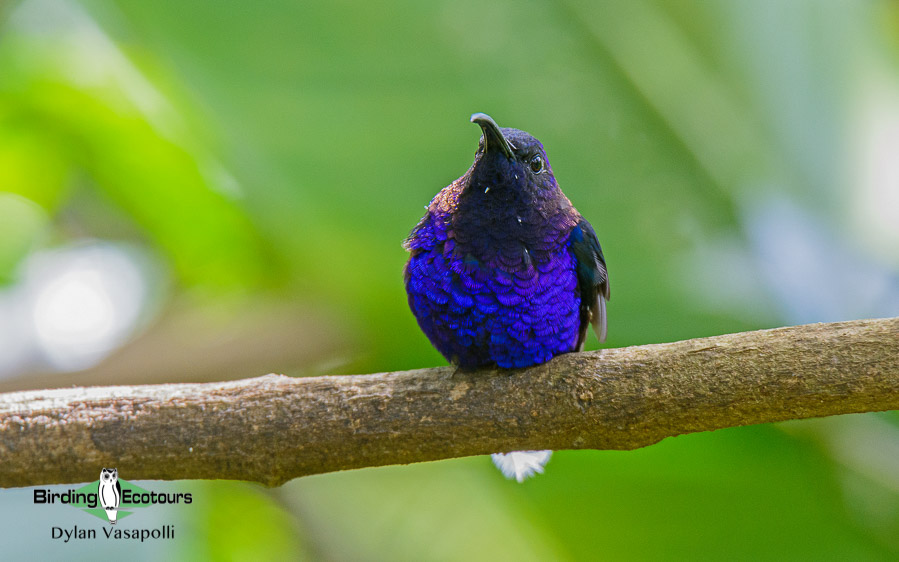
After lunch, we will visit the Cinchona feeders, where we can spend time watching and photographing birds such as Red-headed Barbet, Prong-billed Barbet, Blue-throated Toucanet, Silver-throated, Scarlet-rumped, Crimson-collared, Blue-grey, and Palm Tanagers, and with luck Black Guan and Buff-fronted Quail-Dove. After some great time at the feeders, we will transfer to Sarapiquí where we will look for iconic Caribbean foothills species such as Yellow-throated Toucan, Montezuma Oropendola, White-crowned Parrot, and Grey-headed Chachalaca.
Overnight: Sarapiquí
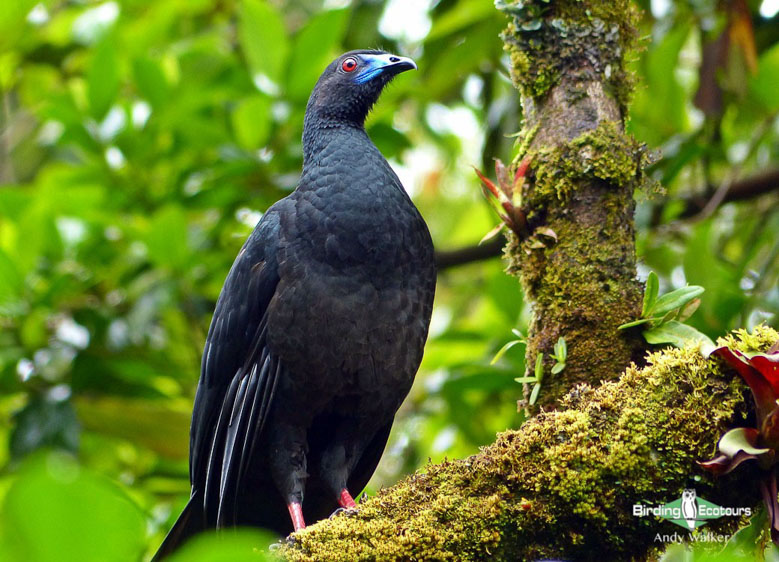
Day 3. La Selva Biological Station
We will have an early start to explore the famous La Selva Biological Station, where we have the chance to find Short-billed and Scaled Pigeons, Brown-hooded Parrot, Great Green Macaw, Snowy Cotinga, White-ringed Flycatcher, Fasciated Antshrike, White-collared Manakin, Crested Guan, Great Antshrike, Red-lored Amazon, and Chestnut-headed and Montezuma Oropendola. In addition, we’ll look for Semiplumbeous Hawk, Chestnut-sided and Buff-rumped Warblers, Great Tinamou, Vermiculated Screech Owl, Great Curassow, Northern Barred Woodcreeper, Rufous-winged, Pale-billed, Chestnut-colored, and Black-cheeked Woodpeckers, Keel-billed Toucan, and perhaps even the secretive Slaty-breasted Tinamou.
Overnight: Sarapiquí
Day 4. Cope Wildlife Reserve and Puerto Viejo
We will have a full morning visiting the famous Cope Wildlife Reserve where we will have excellent opportunities to photograph birds visiting its amazing feeders. Some of the species regularly visiting the feeders might include Bronze-tailed Plumeleteer, Crowned Woodnymph, White-necked Jacobin, Stripe-throated Hermit, White-tipped Sicklebill, Green Hermit, Montezuma and Chestnut-headed Oropendolas, Orange-chinned Parakeet, Black-cheeked Woodpecker, Red-legged, Shining and Green Honeycreepers, and Crimson-collared Tanager. We will also explore some nocturnal bird territories near the reserve to look for potential roosting trees for Crested Owl, Spectacled Owl, and Black-and-white Owl, as well as Great Potoo. The open fields are good for Tropical Mockingbird and Yellow Tyrannulet. We will also have good chances to enjoy some other iconic Costa Rican wildlife including frogs, lizards, and mammals.
Late in the afternoon, we will explore some areas around Puerto Viejo where Great Green Macaw is reliable and other birds such as Slaty Spinetail, Long-tailed Tyrant, Yellow Tyrannulet, Olive-throated Parakeet, Morelet’s and Variable Seedeaters, and Thick-billed Seed Finch may be seen.
Overnight: Sarapiquí
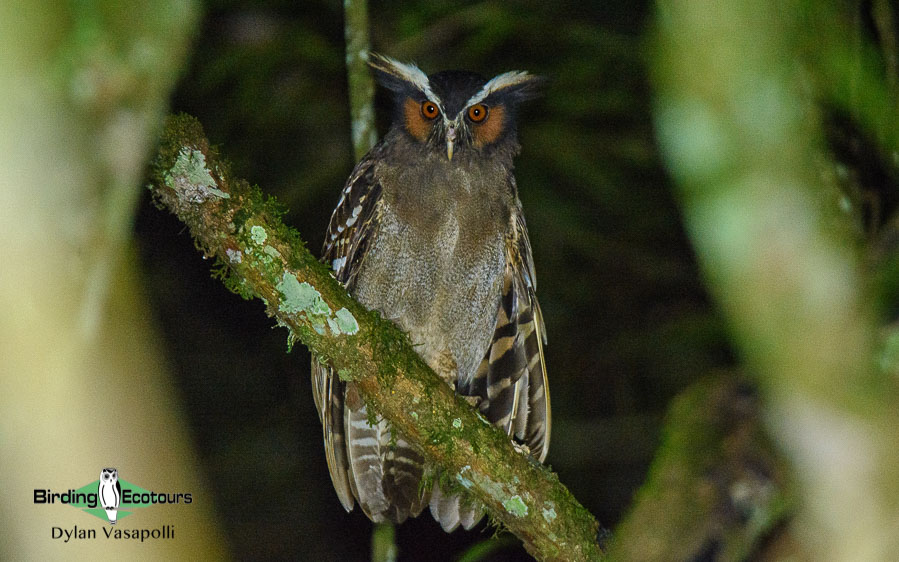
Day 5. Puerto Viejo and transfer to San Gerardo de Dota
Today we will leave Sarapiquí and make our way to San Gerardo de Dota and will break the long drive with a pleasant birding stop along the Sarapiquí River where, with luck, we might find Scarlet Macaw and King Vulture. We also have chances for Mangrove and Southern Rough-winged Swallows, Grey-breasted Martin, Prothonotary Warbler, Wedge-billed Woodcreeper, and Bare-throated Tiger Heron. We will then continue our drive to San Gerardo de Dota and, if time permits, enjoy some birding around Cerro de la Muerte, before reaching the lovely Savegre Lodge.
Overnight: San Gerardo de Dota valley
Day 6. Los Quetzales National Park and Paraiso Los Quetzales Lodge
Today we will drive to the high elevations of Los Quetzales National Park. Once on the high grounds of the park we will focus on the range-restricted Volcano Junco and Timberline Wren. Other species are likely to include Large-footed Finch, Volcano Hummingbird, Black-capped Flycatcher and Red-tailed Hawk. We will then explore the lower areas in search of Black-eared Warbler, the shy Peg-billed Finch, and with luck, Barred Parakeet.
After birding the national park we will visit Paraiso Los Quetzales Lodge where we will enjoy the hummingbird feeders, likely getting views of Fiery-throated, Talamanca, and Volcano Hummingbirds, Grey-tailed Mountaingem and Lesser Violetear. The lodge is also a good place to look for the Mountain Thrush, Ruddy-capped Nightingale-Thrush, Black-billed Nightingale-Thrush, Black-and-yellow Phainoptila, and with luck, Golden-browed Chlorophonia.
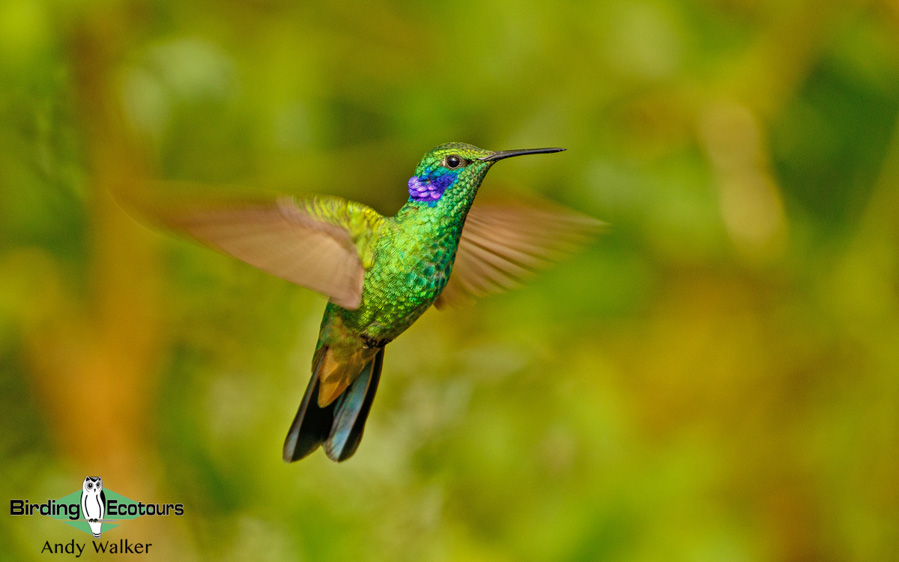
After lunch, we will explore the surroundings of the Cerro de La Muerte and spend the afternoon enjoying some coffee and hummingbirds at Miriam’s Restaurant where we should find Acorn and Hairy Woodpeckers, Sooty-capped Bush Tanager, Golden-browed Chlorophonia, Flame-colored Tanager, Large-footed Finch, Sooty Thrush and perhaps Blue-throated Toucanet. We will leave for our lodge before dusk and try for Dusky Nightjar en route.
Overnight: San Gerardo de Dota valley
Day 7. Savegre Lodge birding
Today we will have an early start to look for Resplendent Quetzal, perhaps the most-wanted bird in Central America. We will visit the most reliable spot in the valley to secure this special sighting. After breakfast, we will spend the morning exploring the lush mountain forest above the lodge, looking for Spotted Wood Quail, Ruddy Treerunner, Spangle-cheeked Tanager, Collared Whitestart, Black-capped Flycatcher, Buffy Tuftedcheek, Ruddy-capped Nightingale-Thrush, Silvery-fronted Tapaculo, and Flame-throated Warbler. Mixed flocks might hold North American migratory warblers such as Chestnut-sided, Black-throated Green, Black-and-white, and Wilson’s Warblers. In addition, we could find Sooty-capped Bush Tanager, Yellowish Flycatcher, Yellow-winged Vireo, Rufous-browed Peppershrike, and Black-faced Solitaire. We will spend the afternoon enjoying some easy birding around the lodge where we will keep an eye out for Finsch’s Parakeet, Long-tailed Silky-flycatcher, Slaty Flowerpiercer, Flame-colored Tanager, Acorn Woodpecker, Red-tailed Hawk, and Stripe-tailed and Scintillant Hummingbirds.
Overnight: San Gerardo de Dota valley
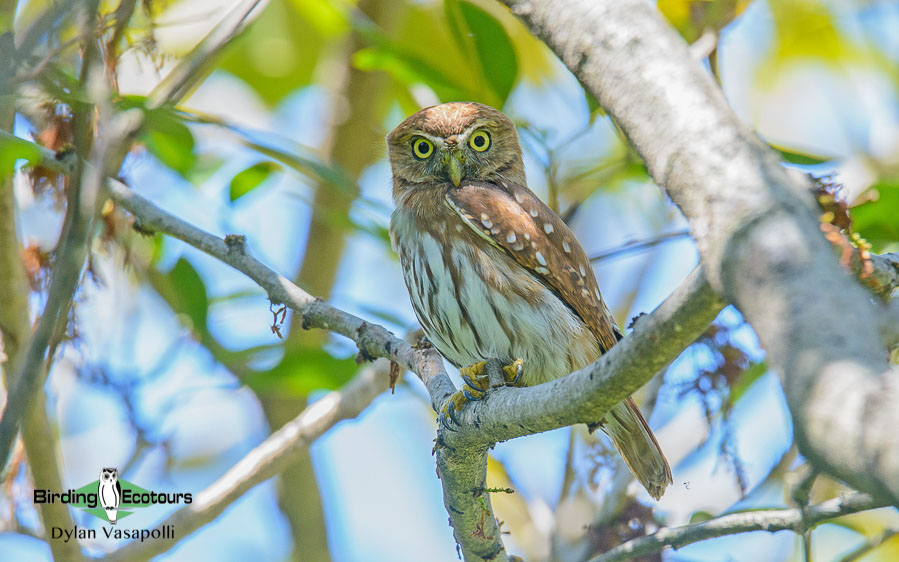
Day 8. Birding Savegre and transfer back to San Jose
We will spend an extra morning around Savegre in case we need another chance to look for the Resplendent Quetzal, if we missed it on the previous day. We can explore the waterfalls road to look for Yellowish Flycatcher, Dark and Ochraceous Pewees, Black-faced Solitaire, and with some luck, American Dipper. After lunch we will be transferred to San Jose’s Hotel Robledal where it is possible to find Ferruginous Pygmy Owl and Jamaican Fruit-eating Bats in the hotel grounds.
Overnight Hotel Robledal, San Jose
Day 9. Transfer to the airport and departure
You will be transferred to San Jose Airport at a convenient time to connect with your international flight
Please note that the itinerary cannot be guaranteed as it is only a rough guide and can be changed (usually slightly) due to factors such as availability of accommodation, updated information on the state of accommodation, roads, or birding sites, the discretion of the guides and other factors. In addition, we sometimes have to use a different international guide from the one advertised due to tour scheduling.
Download ItineraryCosta Rica Escape Part I, January 2025
11 – 19 JANUARY 2025
By Jacob Roalef
DOWNLOAD TRIP REPORT
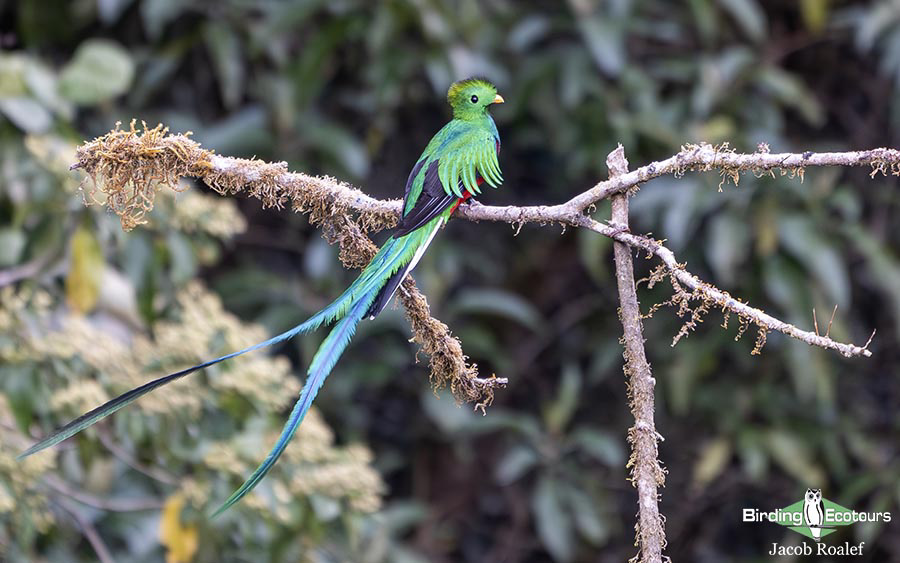
The top highlight of this trip was seeing Resplendent Quetzal on two different days!
Overview
This nine-day tour of Costa Rica was a fantastic introduction to this amazing birding and wildlife destination. The tour touched on a variety of habitats from Caribbean lowlands to cloud forest in upper elevations and everywhere in between. We visited places such as La Paz Waterfall Gardens, La Selva Biological Station, Cope wildlife reserve, Savegre, Paraiso Quetzal, Los Quetzal National Park and many more. We explored Costa Rica at a more relaxed pace and visited a nice variety of feeder stations, along with easy hiking trails and roadside birding, making for a perfect visit to the neotropics for both newer and experienced birders alike.
Even with a relaxed pace, our bird checklist was still long and full of top highlight species! It is hard not to see a plethora of amazing birds while in Costa Rica. Our list included Resplendent Quetzal, Red-headed Barbet, Yellow-eared Toucanet, White-tipped Sicklebill, Coppery-headed Emerald, Bare-shanked Screech Owl, Rufous Motmot, Great Green and Scarlet Macaws, Black-crowned Antshrike, Black-crowned Tityra, Timberline Wren, Volcano Junco, Peg-billed Finch, Black-cheeked Warbler, and so many more.
A total of 223 bird species were seen, with 12 more being heard only species, making for a total of 235 species recorded on the trip. Of course, Costa Rica is home to so much fabulous wildlife aside from birds. We enjoyed many incredible sightings like Strawberry Poison Dart Frog, Eyelash Pit Viper, Boa Constrictor, Brown-throated Three-toed Sloth, and Honduran White Bat. Full bird and mammal checklists can be found at the end of the report.
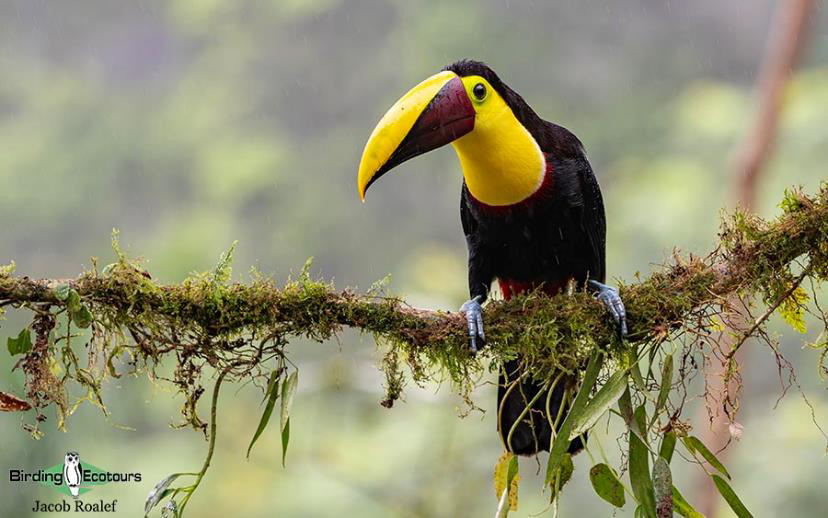
The stunning Yellow-throated Toucan was one of five toucan species seen on this trip!
Detailed Report
Day 1, 11th January 2025. Hotel Bougainvillea and welcome dinner
Several participants arrived in Costa Rica one night early, so, after breakfast, we had our first bit of birding together around the grounds of Hotel Bougainvillea. The hotel hosts some fantastic gardens and space to spread out and bird. Right outside we were immediately greeted by Social Flycatcher, Great Kiskadee, and Clay-colored Thrush. As we continued, we spotted Baltimore Oriole, Crested Caracara, Philadelphia Vireo, Rufous-tailed Hummingbird, and more. The true highlights of our walk this morning came in the form of two Mottled Owls roosting in the bamboo and a stunning Lesson’s Motmot which allowed for fantastic views out in the open. We had the rest of the afternoon to ourselves to rest before we met up again for our first official meal. With the whole group there for dinner, our tour had officially begun.
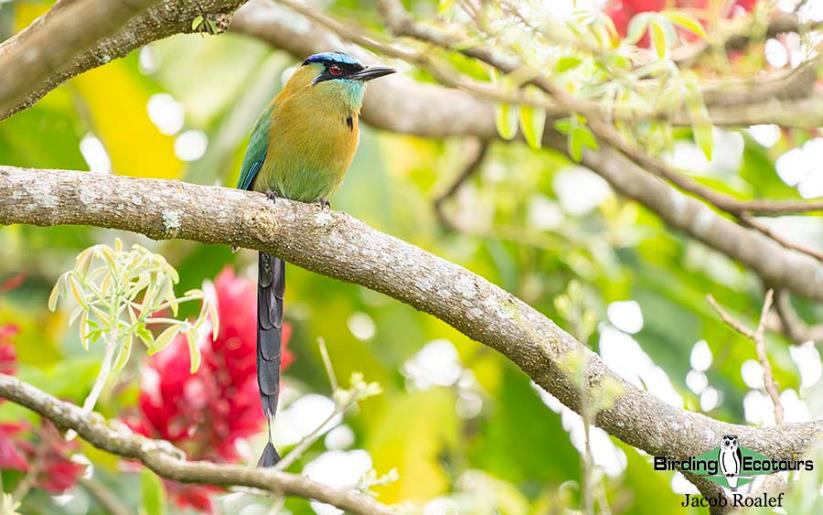
We enjoyed stellar views of Lesson’s Motmot at our hotel.
Day 2, 12th January 2025. La Paz Waterfalls and Cinchona feeders
We began our day with another morning walk around Hotel Bougainvillea. We managed to see several of the key species again this morning that some of the later arrivals missed the previous day like Mottled Owl, Lesson’s Motmot, and Rufous-backed Wren. In addition to these, we added several new trip species such as White-eared Ground Sparrow, Montezuma Oropendola, and Hoffmann’s Woodpecker. After about an hour of birding the gardens, we enjoyed some tasty breakfast and checked out to begin our adventure around Costa Rica. Our first stop was at Freddo Fresas, a nice little garden area with flowers and a few hummingbird feeders. This quick stop was highlighted by a cute Magenta-throated Woodstar visiting the flowers. We also added the exciting Long-tailed Silky-flycatcher before we loaded back up and headed for La Paz Waterfall Gardens. Here we got our first true taste of a hummingbird feeder area as loads of Purple-throated Mountain-gems, Green-crowned Brilliants, Violet Sabrewings, Green Thorntails, Black-bellied Hummingbirds, and Green Hermits buzzed all around us. We also got stellar views of the endemic Coppery-headed Emerald. It was difficult, but we finally managed to tear ourselves away and enjoy some lunch at the café here.
As we finished up our meal, an adventurous Slaty-backed Nightingale-Thrush paid us a visit and amazingly hopped onto one of our tables! That certainly made for an unforgettable experience. With our bellies full, we began our short hike to see the incredible La Paz falls. Our walk was quiet, but we managed some excellent views of Common Chlorospingus and Brown-capped Viero towards the end. Of course, we also had a wonderful experience with the powerful waterfalls here. Next up, more incredible feeders, this time at Cinchona. This little café area hosted some incredible birds such as White-bellied Mountain-gem, Black Guan, Prong-billed Barbet, Blue-throated (Northern Emerald) Toucanet, Crimson-collared and Silver-throated Tanagers, and Buff-throated Saltator. We were almost ready to leave when the final top highlight species made a stunning appearance. The glowing Red-headed Barbet finally showed itself and we even got to see both male and female, what a stunner! Now it was mid-afternoon, and we had some ground to cover to get to the next hotel. We made a few stops along the way and picked up some nice species like Torrent Tyrannulet, Slate-throated Redstart, and Fasciated Tiger-Heron. We arrived at the lodge, got checked in, and enjoyed our dinner together after an amazing day of birding.
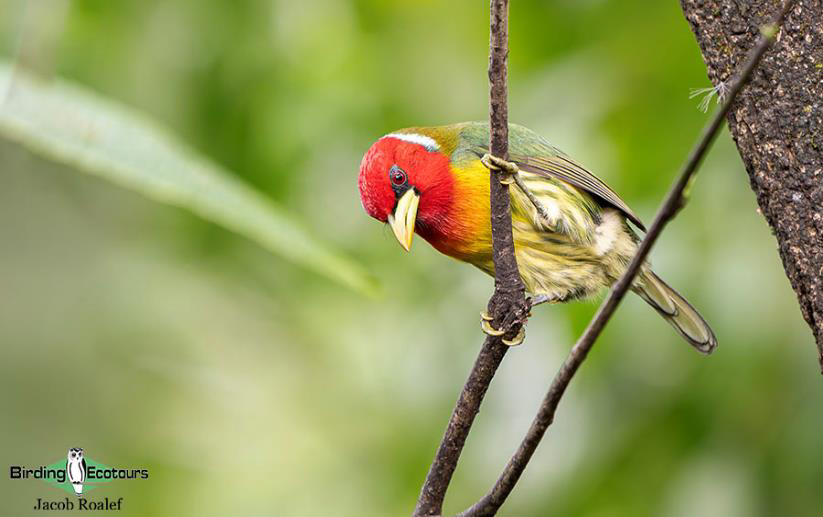
The striking Red-headed Barbet was well worth the wait at Cinchona.
Day 3, 13th January 2025. La Quinta and La Selva Biological Station
This morning started out like all good mornings do in Costa Rica, breakfast, coffee, and amazing birds. We all enjoyed the feeder set up at La Quinta while we awaited breakfast. A fantastic diversity of birds visited the morning fruit set out for them, such as Collared Aracari, Red-throated Ant-Tanager, Golden-hooded Tanager, and Shining, Green, and Red-legged Honeycreepers. After we enjoyed our food and got our gear all set, we headed off for La Selva Biological Station. We spent the entire morning here, birding along the entrance road and east of the Puerto Viejo River. It was an incredible morning full of fantastic sightings. Along the entrance we spotted our first of many Yellow-throated and Keel-billed Toucans as well as Southern Rough-winged Swallow and Green Ibis. From here we sprayed our boots and got onto some of the many trails located here. Our local guides kindly pointed out a Crested Owl hiding in the dense brush, as well as a Great Potoo sleeping way up in a tree, with perfect camouflage. A quick venture down a side trail netted us a Slaty-tailed Trogon, White-collared Manakin, and an incredibly accommodating Semiplumbeous Hawk. We ventured a little bit off trail to see some tiny sleeping Honduran White Bats. On the way back we picked up the always tough Rufous Motmot, as well as an Olive-backed Euphonia and Grey-capped Flycatcher. Three hours later and it was time for lunch, so we headed back to the lodge to rest a little and eat.
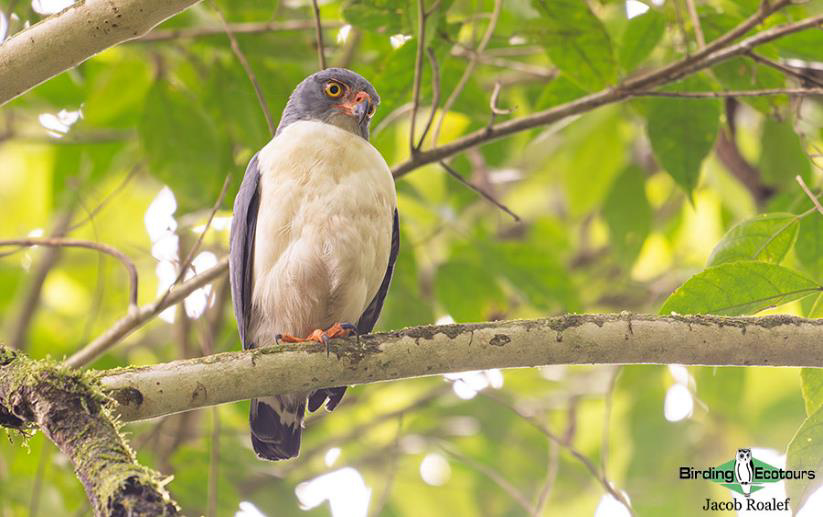
This handsome Semiplumbeous Hawk posed nicely for the group to enjoy.
After lunch, we headed back to La Selva, this time to bird the trails across the river. As we began to cross the bridge, we were treated to a stellar mixed flock. It was difficult to keep up, especially as the bridge would shake at times, but we spotted Golden-winged Warbler, Cinnamon, White-winged, and Rose-throated Becards, Black-crowned Tityra, White-ringed Flycatcher, White-ruffed Manakin, and Rufous-winged Woodpecker, what a flock! Across the river we got onto a territorial Blue-chested Hummingbird, as well as an incredibly confiding Slaty-tailed Trogon. We explored the various trails on the west side and picked some really fantastic species such as Broad-billed Motmot, Black-crowned Antshrike, Streak-headed Woodcreeper, Crested Guan, Black-throated Wren, Black-capped Pygmy-Tyrant, and Ochre-bellied Flycatcher. It was then time to head off and leave La Selva behind, after having had a fantastic day birding there. On our way back to the lodge, we made a quick stop along a side street. Here we got on a Bat Falcon, as well as the critically endangered Great Green Macaw! After a while of enjoying these huge parrots, a pair of Scarlet Macaws were spotted nearby, and we enjoyed those as well. What a great cap to the day!
Day 4, 14th January 2025. The Nest Nature Center and Cope’s
Today started off with a noisy group of Grey-headed Chachalacas at breakfast, along with the slew of other species visiting the morning fruit feeders. After getting fueled up and ready, we departed for the Nest Nature Center. It was a drizzly day, so the covered area near the feeders here was a welcome place to bird from. We enjoyed many species such as Scaly-breasted Hummingbird, Collared Aracari, Hoffmann’s Woodpecker, Orange-chinned Parakeet, White-collared Manakin, Scarlet-rumped Tanager, and Montezuma Oropendola. While we watched the feeder area, we also kept a close eye on the nearby heliconia flowers. Eventually we were treated to a few quick sightings of the amazing, White-tipped Sicklebill. The rain began to lighten up slightly and we all took turns to venture into a sensitive area and see a roosting Striped Owl. It was nearly time to head out, so we headed off in search of our final target. Some other birders had reported this species nearer to the town, so we sped over there and managed to catch up with the difficult Yellow-eared Toucanet in the rain!
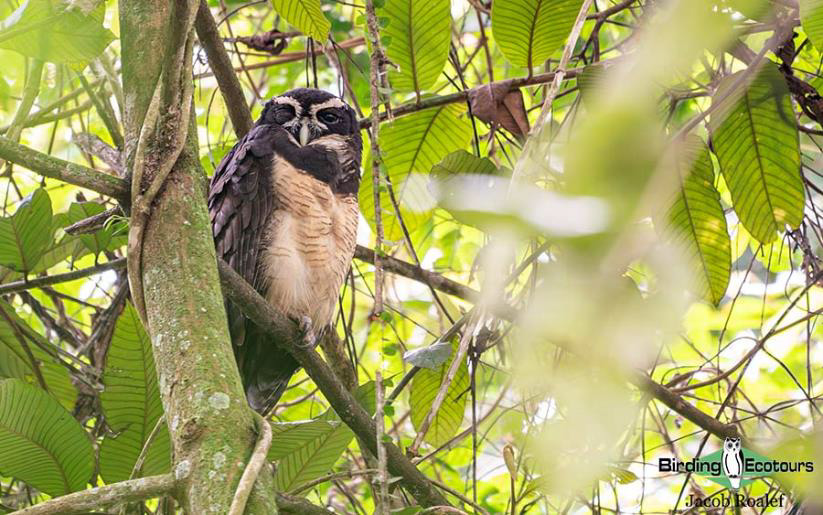
This Spectacled Owl always kept one eye on us.
On our way back to the lodge, we spotted some Scarlet Macaws flying over the road. We managed to track them down in a nearby yard and the homeowners were kind enough to allow us a closer look in their tree. It is always incredible to see these stunning birds up close. The remainder of the day was spent at Cope’s Reserve, a fantastic feeder area as well as nearby forest habitat. At feeders we were treated to a hummingbird show with point blank views of White-necked Jacobin, Green-breasted Mango, Bronze-tailed Plumeleteer, and Long-billed Hermit. Of course, there were more than just hummers here, with Russet-naped Wood-Rail, Olive-backed Euphonia, and Chestnut-headed Oropendola, to name a few. After getting a good fill at the feeders, we headed off to the forest where Cope showed us a pair of roosting Spectacled Owls. While we were there, we also managed to spot a few other great species like Stripe-throated Hermit, Olive-throated Parakeet, Shiny Cowbird, and Thick-billed Seed-Finch. To finish the day, we tried our hand at a little dusk birding back near La Selva. We managed a few heard species like Middle American Screech-Owl and Great Tinamou, plus we had a few views of Common Pauraque in the road. It was time for dinner and rest after a long, but great day of birding!
Day 5, 15th January 2025. Sarapiqui to the cloud forest
Today was mostly used for a travel day to get from the Caribbean lowlands up to the cloud forests in the mountains. We enjoyed the usual morning suspects at our hotel, like Red-legged Honeycreeper, Red-throated Any-Tanager, Blue Dacnis, and Cinnamon-bellied Saltator, before packing up our luggage and saying goodbye. Along our route we made several stops for birding and picked up some nice species like Groove-billed Ani, Blue-black Grassquit, and Morelet’s Seedeater. We made it through San Jose and up into the mountains around lunch where we stopped at Casa Dowii, a fantastic place to eat and bird.
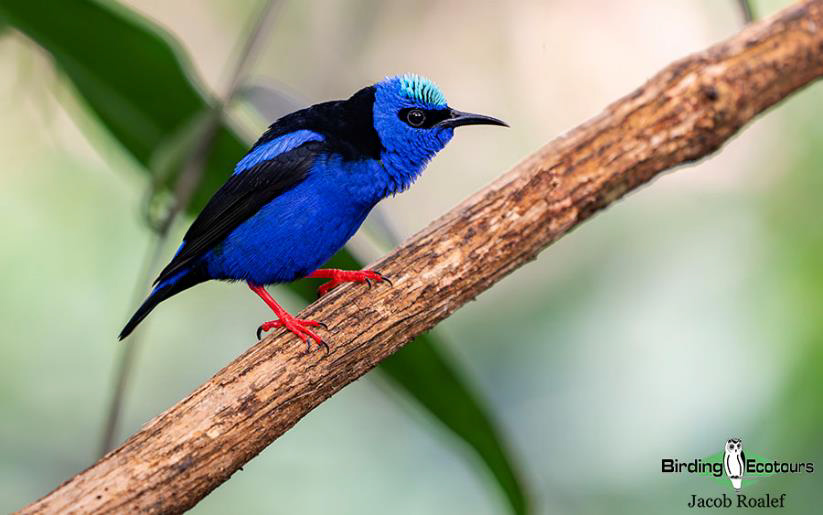
The unforgettable Red-legged Honeycreeper was spotted many times.
It was windy and rainy, but we still managed to spot many new species at our lunch stop. We noticed as the habitat and ecosystem changed, so did the bird assemblage. Highlights here included Buff-fronted Quail-Dove, Red-faced Spinetail, Grey-breasted Wood-Wren, Chestnut-capped, White-naped, and Yellow-thighed Brushfinches, and Flame-colored Tanager. We wrapped up lunch and finished our journey to our next lodge, Hotel Gema, where we checked in and explored the grounds and feeders here before dinner. The misty day certainly didn’t help but we enjoyed the few species around, like Talamanca and Volcano Hummingbirds, Sooty Thrush, and Large-footed Finch. We also took advantage of the weather to catch up on a little rest before sitting down for a tasty dinner to finish the day.
Day 6, 16th January 2025. Los Quetzales National Park and Paraiso Quetzal Lodge
This morning began with an optional walk around our lodge grounds and feeders before breakfast. We enjoyed the feeders, with Grey-tailed Mountain-gem and Talamanca Hummingbird making frequent visits, as well as a small covey of Spotted Wood-Quails coming to some seed on the ground. Our walk produced more great species such as Collared Trogon, Mountain Thrush, and Slaty Flowerpiercer. After breakfast we headed to explore some of the roads in Los Quetzales National Park. It was a beautiful morning for a small hike, and we scored some fantastic species here like Mistletoe Tyrannulet, Ruddy Treerunner, Timberline Wren, Black-and-yellow Silky-flycatcher, and Flame-throated Warbler. Just before it was time to head for lunch we got into an excellent mixed flock with the highlight being Peg-billed Finch, but it also included Sooty-capped Chlorospingus, Black-cheeked Warbler, Flame-colored Tanager, and Black-billed Nightingale-Thrush. The birds moved through quickly, so we loaded up and headed off for lunch.
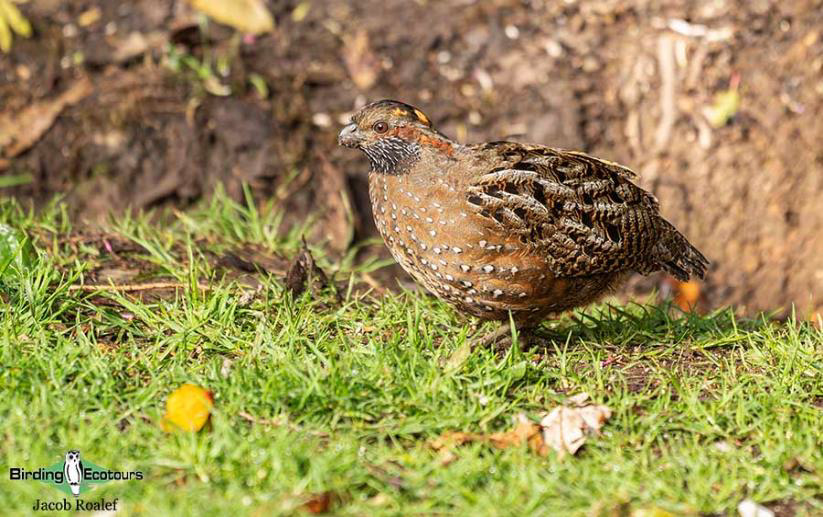
We were treated to daily sightings of Spotted Wood-Quail at Hotel Gema.
Our lunch stops at Paraiso Quetzal Lodge hosted some incredible hummingbird feeders, so we all enjoyed watching these while we waited for our food to be prepared. The main attraction here has to be the many Fiery-throated Hummingbirds zipping around. What an absolutely stunning bird. Of course, other hummers were present as well such as Volcano and Talamanca Hummingbirds, Lesser Violetear, and Grey-tailed Mountain-gem. We also spotted a cute Wilson’s Warbler before enjoying lunch. After eating, we enjoyed the feeders for a little longer, before taking a small break for the afternoon, in anticipation of some evening birding. We headed off around 4pm and birded along the roadside, where we found Collared Redstart and a Purple-throated Mountain-gem, which was a rarity for our elevation level. It was time to wait until dusk, so we began working on our checklist when suddenly we heard several Dusky Nightjars sounding off outside the bus. We filed out in search for them, and we managed to spot them a few times in the road. We began to walk the roadside, and it wasn’t long before a Bare-shanked Screech-Owl called. We managed to track this fantastic species down and get great views of it. A successful night birding session called for some celebration at dinner and a good night’s sleep!
Day 7, 17th January 2025. Savegre Valley and Cerro de la Muerte
We were up and moving early today in anticipation for arguably the top highlight and most desirable species on the trip. After a short hike, we arrived at a great viewing area of many avocado trees where we would wait for the star to show. Thankfully it didn’t take long before we enjoyed the stunning beauty of not one but two Resplendent Quetzals! A pair were enjoying their breakfast, flying from tree to tree while we watched and soaked it all in. Eventually, the birds flew off deeper into the forest and it was time to move on to our next stop, Miriam’s Restaurant.
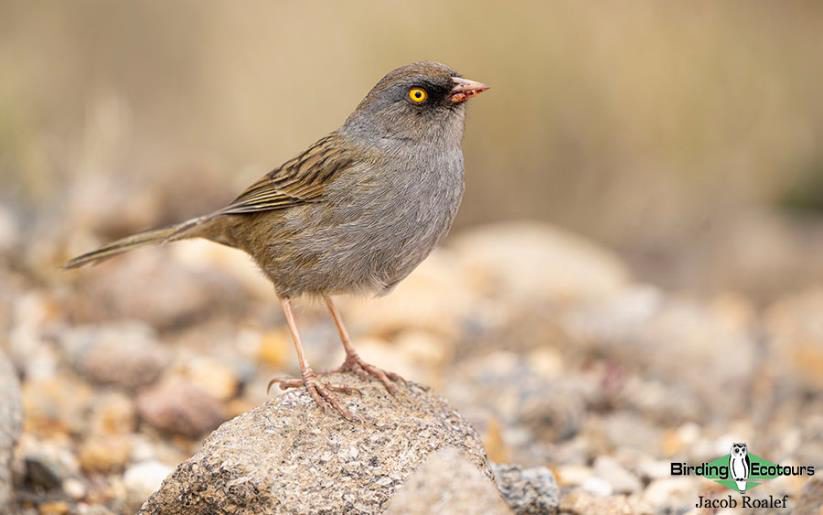
We didn’t have to search long before this Volcano Junco was spotted near the bus.
This small café hosts some nice feeders in the back, and it is a great place to get a cup of coffee as well after an early morning start. We notched several new species here like Acorn Woodpecker, Sooty Thrush, and Large-footed Finch. The remainder of the morning was spent exploring the Savegre Valley area. We followed the Savegre River and quickly picked up a confiding Yellowish Flycatcher as well as Slaty Flowerpiercer and Stripe-tailed Hummingbird. Further upriver we managed to get into a few small mixed flocks which proved to be fruitful. Species such as Red-faced Spinetail, Olive-streaked Flycatcher, Spotted Barbtail, Black-faced Solitaire, and Dark Pewee were enjoyed by all. It was time for lunch, which we enjoyed outside in the beautiful weather, and a flock of White-collared Swifts graced us with some nice views while we ate. Our afternoon consisted of a long journey up to the top of Cerro de la Muerte in search of our final target for the day. Thankfully, after a long journey, it wasn’t very long before a pair of Volcano Juncos appeared right next to our parked vehicle! In fact, these birds continued to come closer and closer until they were practically on our shoes. These high-altitude specialists were a great way to finish the day. We headed back to the lodge for a little down time before dinner.
Day 8, 18th January 2025. Los Quetzals National Park and back to San Jose
Our final full day in Costa Rica began with another pre-breakfast walk around our lodge grounds which netted us a few nice species like Long-tailed Silky-flycatcher and Yellow-winged Vireo. After we ate, we loaded up the bus and headed off. It would be a long day of travel to our hotel near the San Jose airport. Of course, we still had the full morning for birding efforts and hopes of adding some new species. We decided to spend this time exploring a few different sections of Los Quetzals National Park. One of the first birds we heard was a Resplendent Quetzal calling loudly. We unloaded and managed to track it down. It’s tough to beat a morning with a quetzal.
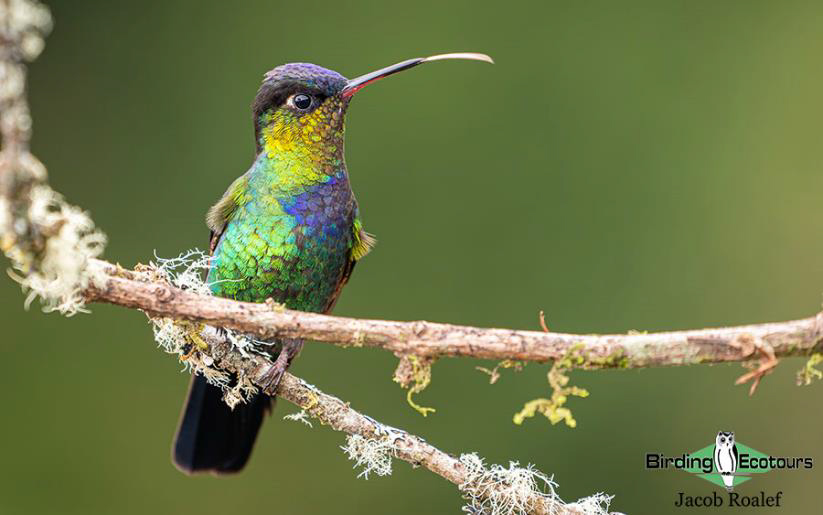
We all enjoyed seeing Fiery-throated Hummingbird one final time before departing.
We continued down the road and picked up other nice birds such as Ruddy Pigeon, Spot-crowned Woodcreeper, White-fronted Tyrannulet, Yellow-bellied Siskin, and Black-cheeked Warbler. At the end of our walk, things picked up and we enjoyed a very confiding Black-capped Flycatcher as well as two new species for the trip, Black-thighed Grosbeak and White-winged Tanager, both really nice birds. For lunch we all wanted to head back to Parisio Quetzal Lodge and spend a little more time with all of the stunning Fiery-throated Hummingbirds there. Finally, it was time to say goodbye to these cute little birds and continue. The rest of the afternoon was full of driving and, sadly, some traffic in San Jose. A few common city birds like House Sparrow and Great-tailed Grackle provided some entertainment from the bus while we crawled along. Eventually we made it to our hotel, checked in, and had our final dinner together, where we discussed our favorite birds, sightings, and moments from the trip, sharing some final laughs and smiles together.
Day 9, 19th January 2025. Departure from San Jose
Our trip concluded this morning with airport transfers to San Jose to catch our flights back home. Some of us had later flights and were able to bird the hotel grounds. We picked up a few new species for the trip, like Cinnamon Hummingbird, Spot-breasted Oriole, and Ferruginous Pygmy Owl. It is always great to add a few new trip birds on the final morning before concluding what was an amazing trip and introduction to neotropical birding.
Bird List – Following IOC (14.2)
Birds ‘heard only’ are marked with (H) after the common name, all other species were seen. Species seen only on the pre-trip day of this trip are marked with (+) after the common name.
The following notation after species names is used to show conservation status following BirdLife International: CE = Critically Endangered, EN = Endangered, VU = Vulnerable, NT = Near Threatened.
| Common Name | Scientific Name |
| Tinamous (Tinamidae) | |
| Great Tinamou (H) | Tinamus major |
| Little Tinamou (H) | Crypturellus soui |
| Ducks, Geese, Swans (Anatidae) | |
| Muscovy Duck | Cairina moschata |
| Chachalacas, Curassows, Guans (Cracidae) | |
| Grey-headed Chachalaca | Ortalis cinereiceps |
| Crested Guan | Penelope purpurascens |
| Black Guan | Chamaepetes unicolor |
| New World Quail (Odontophoridae) | |
| Spotted Wood Quail | Odontophorus guttatus |
| Nightjars (Caprimulgidae) | |
| Pauraque | Nyctidromus albicollis |
| Dusky Nightjar | Antrostomus saturatus |
| Potoos (Nyctibiidae) | |
| Great Potoo | Nyctibius grandis |
| Swifts (Apodidae) | |
| White-collared Swift | Streptoprocne zonaris |
| Grey-rumped Swift | Chaetura cinereiventris |
| Vaux’s Swift | Chaetura vauxi |
| Hummingbirds (Trochilidae) | |
| White-necked Jacobin | Florisuga mellivora |
| White-tipped Sicklebill | Eutoxeres aquila |
| Band-tailed Barbthroat | Threnetes ruckeri |
| Stripe-throated Hermit | Phaethornis striigularis |
| Green Hermit | Phaethornis guy |
| Long-billed Hermit | Phaethornis longirostris |
| Lesser Violetear | Colibri cyanotus |
| Green-breasted Mango | Anthracothorax prevostii |
| Green Thorntail | Discosura conversii |
| Green-crowned Brilliant | Heliodoxa jacula |
| Talamanca Hummingbird | Eugenes spectabilis |
| Fiery-throated Hummingbird | Panterpe insignis |
| White-bellied Mountaingem | Lampornis hemileucus |
| Purple-throated Mountaingem | Lampornis calolaemus |
| Grey-tailed Mountaingem (Endemic) | Lampornis cinereicauda |
| Magenta-throated Woodstar | Philodice bryantae |
| Ruby-throated Hummingbird | Archilochus colubris |
| Volcano Hummingbird | Selasphorus flammula |
| Violet Sabrewing | Campylopterus hemileucurus |
| Bronze-tailed Plumeleteer | Chalybura urochrysia |
| Coppery-headed Emerald (Endemic) | Microchera cupreiceps |
| Stripe-tailed Hummingbird | Eupherusa eximia |
| Black-bellied Hummingbird | Eupherusa nigriventris |
| Scaly-breasted Hummingbird | Phaeochroa cuvierii |
| Cinnamon Hummingbird | Amazilia rutila |
| Rufous-tailed Hummingbird | Amazilia tzacatl |
| Blue-chested Hummingbird | Polyerata amabilis |
| Cuckoos (Cuculidae) | |
| Groove-billed Ani | Crotophaga sulcirostris |
| Squirrel Cuckoo | Piaya cayana |
| Pigeons, Doves (Columbidae) | |
| Rock Dove (Introduced) | Columba livia |
| Band-tailed Pigeon | Patagioenas fasciata |
| Pale-vented Pigeon | Patagioenas cayennensis |
| Red-billed Pigeon | Patagioenas flavirostris |
| Ruddy Pigeon | Patagioenas subvinacea |
| Inca Dove | Columbina inca |
| Ruddy Ground Dove | Columbina talpacoti |
| White-tipped Dove | Leptotila verreauxi |
| Buff-fronted Quail-Dove | Zentrygon costaricensis |
| White-winged Dove | Zenaida asiatica |
| Rails, Crakes & Coots (Rallidae) | |
| Russet-naped Wood Rail | Aramides albiventris |
| Plovers (Charadriidae) | |
| Southern Lapwing | Vanellus chilensis |
| Cormorants and Shags (Phalacrocoracidae) | |
| Neotropic Cormorant | Nannopterum brasilianum |
| Ibises, Spoonbills (Threskiornithidae) | |
| Green Ibis | Mesembrinibis cayennensis |
| Herons, Egrets, and Bitterns (Ardeidae) | |
| Bare-throated Tiger Heron | Tigrisoma mexicanum |
| Fasciated Tiger Heron | Tigrisoma fasciatum |
| Snowy Egret | Egretta thula |
| Great Egret | Ardea alba |
| Western Cattle Egret | Ardea ibis |
| New World Vultures (Cathartidae) | |
| King Vulture | Sarcoramphus papa |
| Black Vulture | Coragyps atratus |
| Turkey Vulture | Cathartes aura |
| Ospreys (Pandionidae) | |
| Osprey | Pandion haliaetus |
| Kites, Hawks, Eagles (Accipitridae) | |
| Semiplumbeous Hawk | Leucopternis semiplumbeus |
| Grey Hawk | Buteo plagiatus |
| Broad-winged Hawk | Buteo platypterus |
| Short-tailed Hawk | Buteo brachyurus |
| Red-tailed Hawk | Buteo jamaicensis |
| Owls (Strigidae) | |
| Ferruginous Pygmy Owl | Glaucidium brasilianum |
| Striped Owl | Asio clamator |
| Bare-shanked Screech Owl | Megascops clarkii |
| Middle American Screech Owl (H) | Megascops guatemalae |
| Spectacled Owl | Pulsatrix perspicillata |
| Crested Owl | Lophostrix cristata |
| Mottled Owl | Strix virgata |
| Trogons (Trogonidae) | |
| Resplendent Quetzal | Pharomachrus mocinno |
| Slaty-tailed Trogon | Trogon massena |
| Northern Black-throated Trogon | Trogon tenellus |
| Collared Trogon (H) | Trogon collaris |
| Motmots (Momotidae) | |
| Lesson’s Motmot | Momotus lessonii |
| Rufous Motmot | Baryphthengus martii |
| Broad-billed Motmot | Electron platyrhynchum |
| New World Barbets (Capitonidae) | |
| Red-headed Barbet | Eubucco bourcierii |
| Toucan Barbets (Semnornithidae) | |
| Prong-billed Barbet | Semnornis frantzii |
| Toucans (Ramphastidae) | |
| Blue-throated Toucanet | Aulacorhynchus caeruleogularis |
| Collared Aracari | Pteroglossus torquatus |
| Yellow-eared Toucanet | Selenidera spectabilis |
| Keel-billed Toucan | Ramphastos sulfuratus |
| Yellow-throated Toucan | Ramphastos ambiguus |
| Woodpeckers (Picidae) | |
| Acorn Woodpecker | Melanerpes formicivorus |
| Black-cheeked Woodpecker | Melanerpes pucherani |
| Hoffmann’s Woodpecker | Melanerpes hoffmannii |
| Yellow-bellied Sapsucker | Sphyrapicus varius |
| Hairy Woodpecker (H) | Leuconotopicus villosus |
| Rufous-winged Woodpecker | Piculus simplex |
| Golden-olive Woodpecker | Colaptes rubiginosus |
| Chestnut-colored Woodpecker | Celeus castaneus |
| Lineated Woodpecker | Dryocopus lineatus |
| Caracaras, Falcons (Falconidae) | |
| Crested Caracara | Caracara plancus |
| Yellow-headed Caracara | Milvago chimachima |
| Bat Falcon | Falco rufigularis |
| African & New World Parrots (Psittacidae) | |
| Orange-chinned Parakeet | Brotogeris jugularis |
| White-crowned Parrot | Pionus senilis |
| Red-lored Amazon | Amazona autumnalis |
| Sulphur-winged Parakeet | Pyrrhura hoffmanni |
| Olive-throated Parakeet | Eupsittula nana |
| Great Green Macaw – CR | Ara ambiguus |
| Scarlet Macaw | Ara macao |
| Finsch’s Parakeet (Crimson-fronted) | Psittacara finschi |
| Ovenbirds (Furnariidae) | |
| Plain-brown Woodcreeper | Dendrocincla fuliginosa |
| Streak-headed Woodcreeper | Lepidocolaptes souleyetii |
| Spot-crowned Woodcreeper | Lepidocolaptes affinis |
| Spotted Barbtail | Premnoplex brunnescens |
| Ruddy Treerunner | Margarornis rubiginosus |
| Red-faced Spinetail | Cranioleuca erythrops |
| Antbirds (Thamnophilidae) | |
| Black-crowned Antshrike | Thamnophilus atrinucha |
| Fasciated Antshrike (H) | Cymbilaimus lineatus |
| Tapaculos (Rhinocryptidae) | |
| Silvery-fronted Tapaculo (H) | Scytalopus argentifrons |
| Tyrant Flycatchers, Calyptura (Tyrannidae) | |
| White-fronted Tyrannulet | Acrochordopus zeledoni |
| Mountain Elaenia | Elaenia frantzii |
| Torrent Tyrannulet | Serpophaga cinerea |
| Yellow Tyrannulet | Capsiempis flaveola |
| Mistletoe Tyrannulet | Zimmerius parvus |
| Olive-streaked Flycatcher | Mionectes olivaceus |
| Ochre-bellied Flycatcher | Mionectes oleagineus |
| Black-capped Pygmy Tyrant | Myiornis atricapillus |
| Common Tody-Flycatcher | Todirostrum cinereum |
| Black Phoebe | Sayornis nigricans |
| Dark Pewee | Contopus lugubris |
| Yellowish Flycatcher | Empidonax flavescens |
| Black-capped Flycatcher | Empidonax atriceps |
| Social Flycatcher | Myiozetetes similis |
| Grey-capped Flycatcher | Myiozetetes granadensis |
| Great Kiskadee | Pitangus sulphuratus |
| White-ringed Flycatcher | Conopias albovittatus |
| Tropical Kingbird | Tyrannus melancholicus |
| Dusky-capped Flycatcher | Myiarchus tuberculifer |
| Great Crested Flycatcher (H) | Myiarchus crinitus |
| Manakins (Pipridae) | |
| White-ruffed Manakin | Corapipo altera |
| White-collared Manakin | Manacus candei |
| Tityras, Becards, Sharpbill (Tityridae) | |
| Black-crowned Tityra | Tityra inquisitor |
| Cinnamon Becard | Pachyramphus cinnamomeus |
| White-winged Becard | Pachyramphus polychopterus |
| Rose-throated Becard | Pachyramphus albogriseus |
| Vireos, Greenlets, Shrike-babblers (Vireonidae) | |
| Lesser Greenlet | Pachysylvia decurtata |
| Philadelphia Vireo | Vireo philadelphicus |
| Brown-capped Vireo | Vireo leucophrys |
| Yellow-winged Vireo | Vireo carmioli |
| Crows, Jays (Corvidae) | |
| Brown Jay (H) | Cyanocorax morio |
| Silky-flycatchers (Ptiliogonatidae) | |
| Black-and-yellow Phainoptila | Phainoptila melanoxantha |
| Long-tailed Silky-flycatcher | Ptiliogonys caudatus |
| Swallows, Martins (Hirundinidae) | |
| Grey-breasted Martin | Progne chalybea |
| Northern Rough-winged Swallow | Stelgidopteryx serripennis |
| Southern Rough-winged Swallow | Stelgidopteryx ruficollis |
| Blue-and-white Swallow | Pygochelidon cyanoleuca |
| Barn Swallow | Hirundo rustica |
| Wrens (Troglodytidae) | |
| Rufous-backed Wren | Campylorhynchus capistratus |
| Black-throated Wren | Pheugopedius atrogularis |
| Bay Wren (H) | Cantorchilus nigricapillus |
| Southern House Wren (H) | Troglodytes musculus |
| Timberline Wren | Thryorchilus browni |
| Grey-breasted Wood Wren (H) | Henicorhina leucophrys |
| Mockingbirds, Thrashers (Mimidae) | |
| Tropical Mockingbird | Mimus gilvus |
| Thrushes (Turdidae) | |
| Black-faced Solitaire | Myadestes melanops |
| Slaty-backed Nightingale-Thrush | Catharus fuscater |
| Black-billed Nightingale-Thrush | Catharus gracilirostris |
| Sooty Thrush | Turdus nigrescens |
| Mountain Thrush | Turdus plebejus |
| Clay-colored Thrush | Turdus grayi |
| Old World Sparrows, Snowfinches (Passeridae) | |
| House Sparrow (Introduced) | Passer domesticus |
| Finches, Euphonias (Fringillidae) | |
| Yellow-bellied Siskin | Spinus xanthogastrus |
| Golden-browed Chlorophonia | Chlorophonia callophrys |
| Yellow-crowned Euphonia | Euphonia luteicapilla |
| Olive-backed Euphonia | Euphonia gouldi |
| New World Sparrows (Passerellidae) | |
| Sooty-capped Chlorospingus | Chlorospingus pileatus |
| Common Chlorospingus | Chlorospingus flavopectus |
| Orange-billed Sparrow | Arremon aurantiirostris |
| Chestnut-capped Brushfinch | Arremon brunneinucha |
| Volcano Junco | Junco vulcani |
| Rufous-collared Sparrow | Zonotrichia capensis |
| Large-footed Finch | Pezopetes capitalis |
| White-eared Ground Sparrow | Melozone leucotis |
| White-naped Brushfinch | Atlapetes albinucha |
| Yellow-thighed Brushfinch | Atlapetes tibialis |
| Oropendolas, Orioles, Blackbirds (Icteridae) | |
| Chestnut-headed Oropendola | Psarocolius wagleri |
| Montezuma Oropendola | Psarocolius montezuma |
| Scarlet-rumped Cacique | Cacicus microrhynchus |
| Baltimore Oriole | Icterus galbula |
| Spot-breasted Oriole | Icterus pectoralis |
| Black-cowled Oriole | Icterus prosthemelas |
| Red-winged Blackbird | Agelaius phoeniceus |
| Shiny Cowbird | Molothrus bonariensis |
| Melodious Blackbird | Dives dives |
| Great-tailed Grackle | Quiscalus mexicanus |
| New World Warblers (Parulidae) | |
| Northern Waterthrush | Parkesia noveboracensis |
| Golden-winged Warbler | Vermivora chrysoptera |
| Black-and-white Warbler | Mniotilta varia |
| Flame-throated Warbler | Oreothlypis gutturalis |
| Tennessee Warbler | Leiothlypis peregrina |
| American Redstart | Setophaga ruticilla |
| Blackburnian Warbler | Setophaga fusca |
| American Yellow Warbler | Setophaga aestiva |
| Chestnut-sided Warbler | Setophaga pensylvanica |
| Black-throated Green Warbler | Setophaga virens |
| Chestnut-capped Warbler | Basileuterus delattrii |
| Black-cheeked Warbler | Basileuterus melanogenys |
| Wilson’s Warbler | Cardellina pusilla |
| Slate-throated Whitestart | Myioborus miniatus |
| Collared Whitestart | Myioborus torquatus |
| Cardinals & Allies (Cardinalidae) | |
| Flame-colored Tanager | Piranga bidentata |
| Summer Tanager | Piranga rubra |
| Red-throated Ant Tanager | Driophlox fuscicauda |
| Black-thighed Grosbeak | Pheucticus tibialis |
| Rose-breasted Grosbeak | Pheucticus ludovicianus |
| Tanagers & Allies (Thraupidae) | |
| Green Honeycreeper | Chlorophanes spiza |
| Red-legged Honeycreeper | Cyanerpes cyaneus |
| Shining Honeycreeper | Cyanerpes lucidus |
| Blue Dacnis | Dacnis cayana |
| Cinnamon-bellied Saltator | Saltator grandis |
| Buff-throated Saltator | Saltator maximus |
| Bananaquit | Coereba flaveola |
| Blue-black Grassquit | Volatinia jacarina |
| Crimson-collared Tanager | Ramphocelus sanguinolentus |
| Scarlet-rumped Tanager | Ramphocelus passerinii |
| Morelet’s Seedeater | Sporophila morelleti |
| Variable Seedeater | Sporophila corvina |
| Thick-billed Seed Finch | Sporophila funerea |
| Peg-billed Finch | Acanthidops bairdi |
| Slaty Flowerpiercer | Diglossa plumbea |
| Blue-grey Tanager | Thraupis episcopus |
| Palm Tanager | Thraupis palmarum |
| Golden-hooded Tanager | Stilpnia larvata |
| Silver-throated Tanager | Tangara icterocephala |
| Total Seen | 223 |
| Total Heard | 12 |
| Total Recorded | 235 |
Mammal List
| Common Name | Scientific Name |
| Three-toed Sloths (Bradypodidae) | |
| Brown-throated Three-toed Sloth | Bradypus variegatus |
| Spider, Howler, and Woolly Monkeys (Atelidae) | |
| Mantled Howler – VU (H) | Alouatta palliata |
| Central American Spider Monkey – EN | Ateles geoffroyi |
| Agoutis and Acouchis (Dasyproctidae) | |
| Central American Agouti | Dasyprocta punctata |
| Squirrels (Sciuridae) | |
| Variegated Squirrel | Sciurus variegatoides |
| New World Leaf-nosed Bats (Phyllostomidae) | |
| Honduran White Bat | Ectophylla alba |
| Raccoons, Coatis, and Allies (Procyonidae) | |
| White-nosed Coati | Nasua narica |
| Peccaries (Tayassuidae) | |
| Collared Peccary | Dicotyles tajacu |
| Total seen | 8 |
DOWNLOAD TRIP REPORT
Please see the downloadable PDF above with the full species lists included. This is a sample trip report. Please email us ([email protected]) for more trip reports from this destination.
COSTA RICA ESCAPE TOUR-SPECIFIC INFORMATION
PLEASE CLICK HERE FOR GENERAL INFORMATION PERTAINING TO ALL OUR COSTA RICA TOURS
Our Costa Rica Escape tour is a great, nine-day trip across one of the most exciting destinations in the neotropics. Our tour will start in San José and will take you to explore the Caribbean foothills in the north where we will have the chance to explore La Selva Biological Station and other famous birding sites. Here we hope to see iconic species such as Snowy Cotinga, Montezuma Oropendola, Keel-billed Toucan, Collared Aracari and Great Green Macaw. There are excellent chances for other wildlife sightings too, with Brown-throated Sloth, Honduran White Bat and Strawberry Poison-dart Frog, all possible. The birding is generally easy-going with ample opportunities to relax and enjoy bird feeding stations. We will spend quality time walking along exciting forest trails. Another part of our tour will take us to the San Gerardo de Dota to explore the cloudforest mountains looking for the incredible Resplendent Quetzal and other specials such as Wrenthrush, Dark Pewee, Spotted Wood Quail, Long-tailed Silky-flycatcher, and Blue-throated Toucanet, while staying at the comfortable Savegre Lodge as our base for three nights.
ARRIVAL INFORMATION
Please e-mail us ([email protected], or contact us in a different way, if preferred) before you book any flights, as the information shown here is just an initial guide. Our tour will start in the city of San José, at San José’s de Costa Rica Juan Santa María International Airport (SJO) which can be reached by flights from most major airports from the US, Europe and Panama City (Panama). You may wish to consult your travel agent to book your most convenient flight, although please contact us if you need any guidance. Your tour leader will be waiting for you at San José Airport with the Birding Ecotours logo displayed and will then transfer you to your nearby hotel. Please be aware that most international flights arrive in San José around midday. We don’t have any birding activities planned for the first afternoon but we can enjoy birding around the hotel grounds where we can get a nice set of birds. In case you arrive on an early flight, you will be transferred to the hotel but may have to wait until check-in is available (normally in the early afternoon, although you can easily pass the time wandering around the hotel grounds). For an early check-in, you might be charged extra directly by the hotel; this cost is not included in the Birding Ecotours tour price.
Please remember to keep your luggage tags, as they are required to exit the terminal at the San José Airport.
When filling out the customs declaration form, please use the hotel address below:
Hotel Boungainvillea Santo Tomás, Heredia, Santo Domingo, 40302, Costa Rica
DEPARTURE INFORMATION
Our tour will end in the city of San José after a wonderful nine days in Costa Rica. On the final morning you will be transferred to the San José Airport (SJO) from where you can catch your connecting flight.
DOMESTIC FLIGHT INFORMATION
There are not domestic flights needed on this birding tour.
PHYSICAL REQUIREMENTS AND PACE
We grade this trip as easy, with most of the birding consisting of walking along roads, although some of them lead up and down hills. We will explore some forest trails in the cloudforest and Caribbean slope which have gentle undulations, and there may be muddy sections after rain. Nevertheless, Costa Rica does not require long, hard mountain walks as do some other Birding Ecotours destinations like Peru, Guatemala, or Ecuador. We will spend quality time sitting and enjoying hummingbird feeders and birding the lodge grounds at a number of destinations on this tour.
Keep in mind that (as is usual on most birding trips) we need to be awake very early in the mornings, and pre-dawn starts are required each day. We normally spend the whole morning birding in the field, before returning to the lodge for lunch, after which we often enjoy some downtime and then continue our birding in the late afternoon. Your guide will sometimes invite you to look for owls at night, however this is an optional activity that you can skip if you feel tired. Some people prefer to rest, skipping birding in the afternoon; this can be done at those lodges where we are staying more than one night. When we make birding stops while traveling from location to location, those who feel tired do not have to follow the group and can remain and rest in the vehicle.
We think this trip may be difficult for people with back, walking, and balance problems or for those who are not used to a birding trip with early morning starts.
ATM MACHINES
ATM machines are only available at San José Airport and we suggest drawing US dollars here (for personal expenses such as bar bills, laundry, phone calls, etc). We recommend drawing all the cash (US dollars) you expect to need on the tour at the airport, as ATM machines are not easily accessible elsewhere on the tour itinerary. Please note that although most destinations will accept credit cards, some of the more remote locations may not offer these facilities.
ALTITUDE
We will reach the highest elevation of the tour at Los Quetzales National Park at 10,170 feet (3,190 meters) above sea level. Please ask your doctor if you have any medical conditions that might be aggravated by high elevations. However, we will likely only spend 1-2 hours at this elevation, as we are only looking for two special targets here; Volcano Junco and Timberline Wren. Normally we find these birds fairly quickly and we have not had any problems with altitude sickness in the past.
WEATHER
We ask you to be ready for all kinds of weather during this trip. Areas such as Sarapiqui, El Tapir, Cope Wildlife Reserve and La Selva Biological Station in the Caribbean foothills are hot and humid with temperatures reaching 30°C (86°F). We suggest packing clothes in which you feel most comfortable for this kind of weather. We highly recommend using sunscreen and a light-colored hat or cap. We might also get some rain during our visit in the Caribbean tropical forest!
The weather in the cloudforest of San Gerardo de Dora, Savegre Lodge, Irazú Volcano and the Quetzales National Park can be sunny and humid around midday but cold in the early morning and night, with temperatures dropping to 8°C (46°F).
Please check here for a list of what we recommend bringing.
LAUNDRY
Laundry services are available at Hotel Boungavillea, Savegre Lodge and La Quinta Sarapiquí Country Inn. Laundry fees are not included in the tour price.
ACCOMMODATION
Accommodation is of a very good standard during the tour with rooms including en suite bathrooms, hot showers and air conditioning (in warmer areas only).
TRANSPORT
We will have a private van for the whole tour with plenty of room for everybody. We will require 4×4 vehicle transfers to reach a couple of birding spots above Savegre Lodge. The drive should only take a few minutes but participants should be fit enough to climb in and out of the 4×4 vehicles.
‘The Costa Rica Escape tour was my second trip with Birding Ecotours, after Brazil. It was a great winter break and also a teaser trip to the country, leaving us wanting to see more. Any trip with a Resplendent Quetzal has to be a good one, but the variety of birds we saw at the various stops was amazing. One of the highlight memories for me was when Eduardo and the local guide were off the trail, listening for an owl, and a Great Tinamou walked right up to their feet without them realizing it. As a guide, Eduardo is professional, knowledgeable and personable. I’m already planning my third trip with the company!’
Tracy

